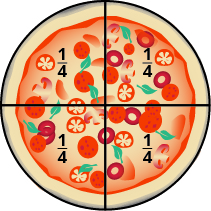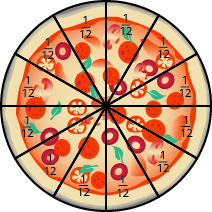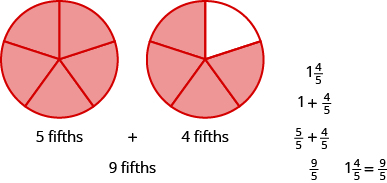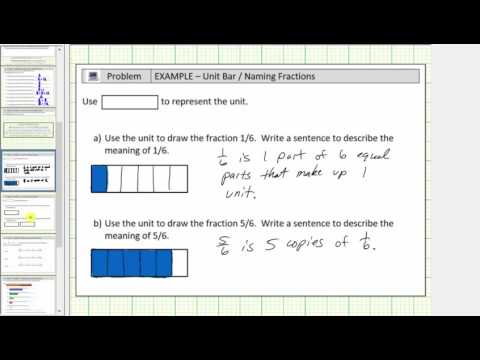1.19: Convert Between Types of Fractions
- Page ID
- 45757
\( \newcommand{\vecs}[1]{\overset { \scriptstyle \rightharpoonup} {\mathbf{#1}} } \)
\( \newcommand{\vecd}[1]{\overset{-\!-\!\rightharpoonup}{\vphantom{a}\smash {#1}}} \)
\( \newcommand{\id}{\mathrm{id}}\) \( \newcommand{\Span}{\mathrm{span}}\)
( \newcommand{\kernel}{\mathrm{null}\,}\) \( \newcommand{\range}{\mathrm{range}\,}\)
\( \newcommand{\RealPart}{\mathrm{Re}}\) \( \newcommand{\ImaginaryPart}{\mathrm{Im}}\)
\( \newcommand{\Argument}{\mathrm{Arg}}\) \( \newcommand{\norm}[1]{\| #1 \|}\)
\( \newcommand{\inner}[2]{\langle #1, #2 \rangle}\)
\( \newcommand{\Span}{\mathrm{span}}\)
\( \newcommand{\id}{\mathrm{id}}\)
\( \newcommand{\Span}{\mathrm{span}}\)
\( \newcommand{\kernel}{\mathrm{null}\,}\)
\( \newcommand{\range}{\mathrm{range}\,}\)
\( \newcommand{\RealPart}{\mathrm{Re}}\)
\( \newcommand{\ImaginaryPart}{\mathrm{Im}}\)
\( \newcommand{\Argument}{\mathrm{Arg}}\)
\( \newcommand{\norm}[1]{\| #1 \|}\)
\( \newcommand{\inner}[2]{\langle #1, #2 \rangle}\)
\( \newcommand{\Span}{\mathrm{span}}\) \( \newcommand{\AA}{\unicode[.8,0]{x212B}}\)
\( \newcommand{\vectorA}[1]{\vec{#1}} % arrow\)
\( \newcommand{\vectorAt}[1]{\vec{\text{#1}}} % arrow\)
\( \newcommand{\vectorB}[1]{\overset { \scriptstyle \rightharpoonup} {\mathbf{#1}} } \)
\( \newcommand{\vectorC}[1]{\textbf{#1}} \)
\( \newcommand{\vectorD}[1]{\overrightarrow{#1}} \)
\( \newcommand{\vectorDt}[1]{\overrightarrow{\text{#1}}} \)
\( \newcommand{\vectE}[1]{\overset{-\!-\!\rightharpoonup}{\vphantom{a}\smash{\mathbf {#1}}}} \)
\( \newcommand{\vecs}[1]{\overset { \scriptstyle \rightharpoonup} {\mathbf{#1}} } \)
\( \newcommand{\vecd}[1]{\overset{-\!-\!\rightharpoonup}{\vphantom{a}\smash {#1}}} \)
\(\newcommand{\avec}{\mathbf a}\) \(\newcommand{\bvec}{\mathbf b}\) \(\newcommand{\cvec}{\mathbf c}\) \(\newcommand{\dvec}{\mathbf d}\) \(\newcommand{\dtil}{\widetilde{\mathbf d}}\) \(\newcommand{\evec}{\mathbf e}\) \(\newcommand{\fvec}{\mathbf f}\) \(\newcommand{\nvec}{\mathbf n}\) \(\newcommand{\pvec}{\mathbf p}\) \(\newcommand{\qvec}{\mathbf q}\) \(\newcommand{\svec}{\mathbf s}\) \(\newcommand{\tvec}{\mathbf t}\) \(\newcommand{\uvec}{\mathbf u}\) \(\newcommand{\vvec}{\mathbf v}\) \(\newcommand{\wvec}{\mathbf w}\) \(\newcommand{\xvec}{\mathbf x}\) \(\newcommand{\yvec}{\mathbf y}\) \(\newcommand{\zvec}{\mathbf z}\) \(\newcommand{\rvec}{\mathbf r}\) \(\newcommand{\mvec}{\mathbf m}\) \(\newcommand{\zerovec}{\mathbf 0}\) \(\newcommand{\onevec}{\mathbf 1}\) \(\newcommand{\real}{\mathbb R}\) \(\newcommand{\twovec}[2]{\left[\begin{array}{r}#1 \\ #2 \end{array}\right]}\) \(\newcommand{\ctwovec}[2]{\left[\begin{array}{c}#1 \\ #2 \end{array}\right]}\) \(\newcommand{\threevec}[3]{\left[\begin{array}{r}#1 \\ #2 \\ #3 \end{array}\right]}\) \(\newcommand{\cthreevec}[3]{\left[\begin{array}{c}#1 \\ #2 \\ #3 \end{array}\right]}\) \(\newcommand{\fourvec}[4]{\left[\begin{array}{r}#1 \\ #2 \\ #3 \\ #4 \end{array}\right]}\) \(\newcommand{\cfourvec}[4]{\left[\begin{array}{c}#1 \\ #2 \\ #3 \\ #4 \end{array}\right]}\) \(\newcommand{\fivevec}[5]{\left[\begin{array}{r}#1 \\ #2 \\ #3 \\ #4 \\ #5 \\ \end{array}\right]}\) \(\newcommand{\cfivevec}[5]{\left[\begin{array}{c}#1 \\ #2 \\ #3 \\ #4 \\ #5 \\ \end{array}\right]}\) \(\newcommand{\mattwo}[4]{\left[\begin{array}{rr}#1 \amp #2 \\ #3 \amp #4 \\ \end{array}\right]}\) \(\newcommand{\laspan}[1]{\text{Span}\{#1\}}\) \(\newcommand{\bcal}{\cal B}\) \(\newcommand{\ccal}{\cal C}\) \(\newcommand{\scal}{\cal S}\) \(\newcommand{\wcal}{\cal W}\) \(\newcommand{\ecal}{\cal E}\) \(\newcommand{\coords}[2]{\left\{#1\right\}_{#2}}\) \(\newcommand{\gray}[1]{\color{gray}{#1}}\) \(\newcommand{\lgray}[1]{\color{lightgray}{#1}}\) \(\newcommand{\rank}{\operatorname{rank}}\) \(\newcommand{\row}{\text{Row}}\) \(\newcommand{\col}{\text{Col}}\) \(\renewcommand{\row}{\text{Row}}\) \(\newcommand{\nul}{\text{Nul}}\) \(\newcommand{\var}{\text{Var}}\) \(\newcommand{\corr}{\text{corr}}\) \(\newcommand{\len}[1]{\left|#1\right|}\) \(\newcommand{\bbar}{\overline{\bvec}}\) \(\newcommand{\bhat}{\widehat{\bvec}}\) \(\newcommand{\bperp}{\bvec^\perp}\) \(\newcommand{\xhat}{\widehat{\xvec}}\) \(\newcommand{\vhat}{\widehat{\vvec}}\) \(\newcommand{\uhat}{\widehat{\uvec}}\) \(\newcommand{\what}{\widehat{\wvec}}\) \(\newcommand{\Sighat}{\widehat{\Sigma}}\) \(\newcommand{\lt}{<}\) \(\newcommand{\gt}{>}\) \(\newcommand{\amp}{&}\) \(\definecolor{fillinmathshade}{gray}{0.9}\)Learning Outcomes
- Identify different types of fractions and convert between them
Andy and Bobby love pizza. On Tuesday night, Andy and Bobby share a pizza with their parents, Fred and Christy, with each person getting an equal amount of the whole pizza. How much of the pizza does each person get? There is one whole pizza, divided evenly into four equal parts. Each person has one of the four equal parts, so each has \(\Large{\frac{1}{4}}\) of the pizza.

On Wednesday, the family invites some friends over for a pizza dinner. There are a total of \(12\) people. If they share the pizza equally, each person would get \(\Large{\frac{1}{12}}\) of the pizza.

Fractions
A fraction is written \(\Large{\frac{a}{b}}\), where \(a\) and \(b\) are integers and \(b\ne 0\). In a fraction, \(a\) is called the numerator and \(b\) is called the denominator.
A fraction is a way to represent parts of a whole. The denominator \(b\) represents the number of equal parts the whole has been divided into, and the numerator \(a\) represents how many parts are included. The denominator, \(b\), cannot equal zero because division by zero is undefined.
In the image below, the circle has been divided into three parts of equal size. Each part represents \(\Large{\frac{1}{3}}\) of the circle. This type of model is called a fraction circle. Other shapes, such as rectangles, can also be used to model fractions.

What does the fraction \(\Large{\frac{2}{3}}\) represent? The fraction \(\Large{\frac{2}{3}}\) means two of three equal parts.

Watch the following video to see more examples of how to write fractions given a model.
Mixed Numbers and Improper Fractions
What would happen if you have eight equal fifth pieces. You can use five of them to make one whole, but you’ll have three fifths left over. Let us use fraction notation to show what happened. You had eight pieces, each of them one fifth, \({\Large\frac{1}{5}}\), so altogether you had eight fifths, which we can write as \({\Large\frac{8}{5}}\). The fraction \({\Large\frac{8}{5}}\) is one whole, \(1\), plus three fifths, \({\Large\frac{3}{5}}\), or \(1{\Large\frac{3}{5}}\), which is read as one and three-fifths.
The number \(1{\Large\frac{3}{5}}\) is called a mixed number.
Mixed Numbers
A mixed number consists of a whole number \(a\) and a fraction \({\Large\frac{b}{c}}\) where \(c\ne 0\). It is written as follows.
\(a{\Large\frac{b}{c}}\text{, }c\ne 0\)
The number \({\Large\frac{8}{5}}\) is called an improper fraction.
Proper and Improper Fractions
The fraction \({\Large\frac{a}{b}}\) is a proper fraction if \(a<b\) and an improper fraction if \(a\ge b\).
Fractions such as \({\Large\frac{5}{4}},{\Large\frac{3}{2}},{\Large\frac{5}{5}}\), and \({\Large\frac{7}{3}}\) are called improper fractions. In an improper fraction, the numerator is greater than or equal to the denominator, so its value is greater than or equal to one. When a fraction has a numerator that is smaller than the denominator, it is called a proper fraction, and its value is less than one. Fractions such as \({\Large\frac{1}{2}},{\Large\frac{3}{7}}\), and \({\Large\frac{11}{18}}\) are proper fractions.
Example
Draw a figure to model \({\Large\frac{11}{8}}\).
[reveal-answer q=”992194″]Show Answer[/reveal-answer]
[hidden-answer a=”992194″]
Solution:
The denominator of the improper fraction is \(8\). Draw a circle divided into eight pieces and shade all of them. This takes care of eight eighths, but we have \(11\) eighths. We must shade three of the eight parts of another circle.

So, \({\Large\frac{11}{8}}=1{\Large\frac{3}{8}}\).
[/hidden-answer]
Try it
Draw a figure to model \({\Large\frac{7}{6}}\)
[reveal-answer q=”924546″]Show Answer[/reveal-answer]
[hidden-answer a=”924546″]

[/hidden-answer]
Draw a figure to model \({\Large\frac{6}{5}}\)
[reveal-answer q=”203648″]Show Answer[/reveal-answer]
[hidden-answer a=”203648″]

[/hidden-answer]
Example
Name the improper fraction modeled. Then write the improper fraction as a mixed number.

[reveal-answer q=”670905″]Show Answer[/reveal-answer]
[hidden-answer a=”670905″]
Solution:
Each circle is divided into three pieces, so each piece is \({\Large\frac{1}{3}}\) of the circle. There are four pieces shaded, so there are four thirds or \({\Large\frac{4}{3}}\). The figure shows that we also have one whole circle and one third, which is \(1{\Large\frac{1}{3}}\). So, \({\Large\frac{4}{3}}=1{\Large\frac{1}{3}}\).[/hidden-answer]
try it
[ohm_question]145976[/ohm_question]
[ohm_question]145977[/ohm_question]
Example
Use a model to rewrite the improper fraction \({\Large\frac{11}{6}}\) as a mixed number.
[reveal-answer q=”121702″]Show Answer[/reveal-answer]
[hidden-answer a=”121702″]
Solution:
We start with \(11\) sixths \(\left({\Large\frac{11}{6}}\right)\). We know that six sixths makes one whole.
\({\Large\frac{6}{6}}=1\)
That leaves us with five more sixths, which is \({\Large\frac{5}{6}}\) (11 sixths minus 6 sixths is 5 sixths).
So, \({\Large\frac{11}{6}}=1{\Large\frac{5}{6}}\)

[/hidden-answer]
Try it
[ohm_question]145982[/ohm_question]
In the next video we show another way to draw a model that represents a fraction. You will see example of both proper and improper fractions shown.
Example
Use a model to rewrite the mixed number \(1{\Large\frac{4}{5}}\) as an improper fraction.
[reveal-answer q=”852331″]Show Answer[/reveal-answer]
[hidden-answer a=”852331″]
Solution:
The mixed number \(1{\Large\frac{4}{5}}\) means one whole plus four fifths. The denominator is \(5\), so the whole is \({\Large\frac{5}{5}}\). Together five fifths and four fifths equals nine fifths.
So, \(1{\Large\frac{4}{5}}={\Large\frac{9}{5}}\)

[/hidden-answer]
Try it
[ohm_question]145981[/ohm_question]
There is another method to turning a mixed number into an improper fraction — it’s just a shortcut to what you’ve been practicing above.
Mixed Numbers to Improper Fractions
- Multiply the whole number by the denominator
- Add that value to the numerator (this becomes the numerator of the improper fraction)
- Place the denominator of the mixed number in the denominator of the improper fraction
EXAMPLE
Convert \(5\frac{2}{3}\) into an improper fraction using the shortcut
| 1. Multiply the whole number by the denomimator | \(5\cdot{3}=15\) |
| 2. Add that value to the numerator | \(15+2=17\) |
| new numerator for improper fraction | \(\Large\frac{17}{?}\) |
| 3. Place the denominator of the mixed number in the denominator of the improper fraction | \(\Large\frac{17}{3}\) |
TRY IT
[ohm_question]156957[/ohm_question]




